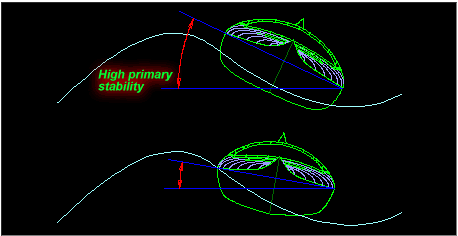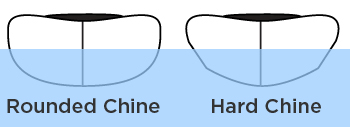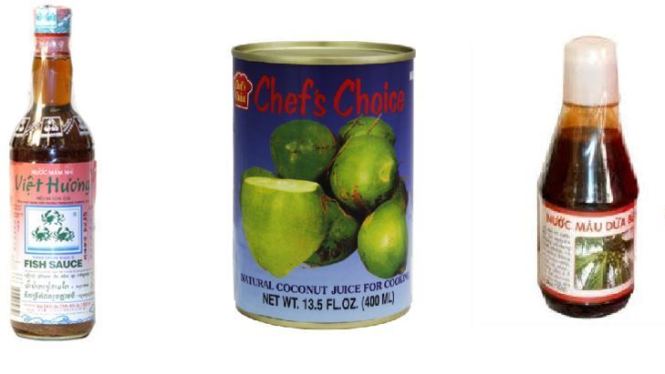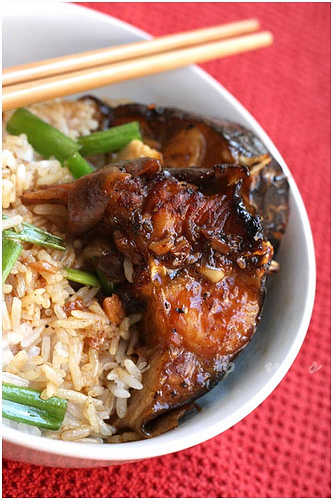If you are new to kayak fishing, learning how to interpret the wind is an important step in getting out on the bays safely. The question “What is a safe wind speed for a beginner kayaker?” comes up frequently on kayak fishing forums and unfortunately as with most things there isn’t a simple numerical answer because there are many variables to consider; experience, type of kayak, type of fishing intended to name just a few.
Fishing kayaks by nature, particularly those designed for standing and casting tend to have a lot of free-board in their design. This is the distance from the waterline to the lowest portion of the gunwale. This is what helps give these types of kayak a drier ride but the trade off is that they catch more wind and therefore tend to drift faster. While this can be offset for fishing purposes by using a drogue (sea anchor) the extra free-board will also make progress back into the head wind a little harder when you realise you have drifted too far out.
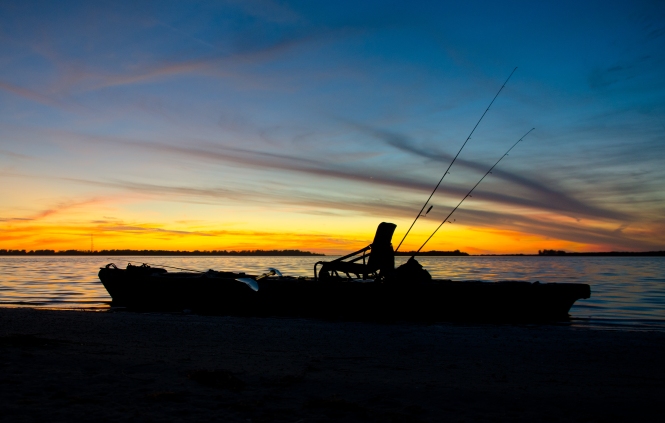
Comfortable and dry, but the trade-off is freeboard.
The answers to the commonly asked questions below will hopefully help you decide whether or not it is worth loading the yak on the roof, and making the trip to the water.
What are the typical easy spots to start out at?
Assuming that you have already spent some sessions on the water without fishing gear getting used to your yak and practising deep water re-entries, there are plenty of beginner friendly spots on both of Melbourne’s bays. Easy launches are the ones with low tide flow on a day with light winds (<10 knots typically). The North of Port Phillip Bay and Reef Island and Coronet Bay areas of Western Port can be considered more beginner friendly spots with all-tide launches and lower tide flows.
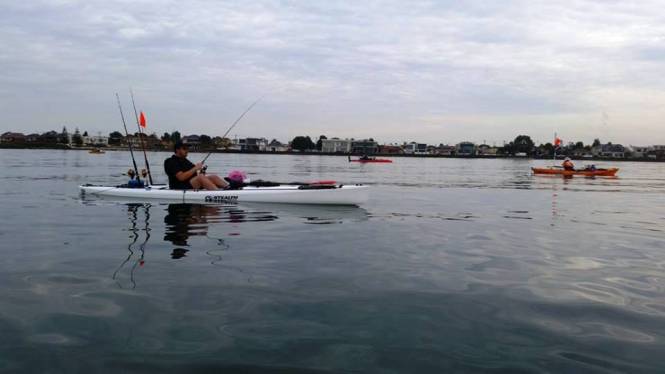
Glassed out conditions in the top end of Port Phillip Bay
Where can I get reputable forecast information?
Some may consider it overkill, but my process for checking wind is as follows:
- Start with the general forecast for the bay on BOM located here
- Then go to BOM Meteye for a more specific wind forecast located here
- I then check the tide curve info on Fish Ranger or WillyWeather
- Finally once at the launch I compare the forecast to the realtime data on Baywinds here
What data points do experienced yakkers look at before they make a decision to go out?
Wind strength
I get the wind speed in knots for the duration of my intended trip and for the hours either side. If you are getting conflicting reports, go with the higher values.
Here is a good kayaking guide to what the water looks like at various wind strengths:
http://www.kayarchy.com/html/03thesea/003wind.htm
Consider the conditions along with the type of fishing planned. If you are drifting flicking soft plastics for example, you might be going too fast even with a drogue out. If you are soaking baits at anchor however it might not matter as much provided you can anchor and retrieve safely in wind and you don’t mind a few waves coming in over the back.
Wind direction
Compare the wind direction to a map of your intended launch on Google maps or marine charts if you have them. If the wind is coming onshore (from the water towards land) the bays will have chop ( short sharp wind waves not to be confused with swell) if the wind is offshore (from land out into the bay) then the water will be flatter. Ideally you should aim to find ‘lee’ to fish comfortably. The beauty of the Melbourne’s bays is that for those willing to travel there is always ‘lee’ somewhere! There is another consideration though, while offshore winds flatten out the water, they also blow you away from your launch and you have to paddle/peddle against it to get home. With onshore winds you paddle out against it initially but have a following sea coming back.
Fetch
Another wind feature to be aware of is ‘fetch’. Fetch is the amount of water the wind has travelled over before getting to you. The longer the fetch length, the more energy the waves will have. For example if you are fishing at St Kilda or Williamstown in a Northerly wind it will have very little fetch but if you fished the same locations in a Southerly the wind will have travelled the length of the bay over water before it gets to you.

Credit: Weatherology
Tides
In areas where the tide flows hard, (bottom of both bays) the direction a tide is going compared to the wind can affect the water. Tide and wind in the same direction is good, tide and wind in opposite directions stands the water up and tide and wind in 90 degrees to each other means you boat will swing at anchor and it is harder to keep your lines where you want them.
Local knowledge of the launch area
Fishing a new spot is probably best done with someone who knows the area, they might not give you their spot X but are very likely to warn you of local hazards; strong tides, exposed reef, bommies etc. If you can’t fish with someone you can learn a lot by visiting the launch spot beforehand at low tide to look for obstacles that are hidden at high tide.
Knowledge of your own equipment
My earlier article on kayak hull design outlines the pro’s and con’s of various fishing kayak hull shapes, but you should also consider the current seaworthiness of your boat. Did you use sealant for any modifications you carried out? Are things like rod holders or sounders going to block or restrict your paddle stroke if you need to get off the water in a hurry? Have you placed accessories in such a way that will impede your ability to re-enter your kayak from deep water.
Safety gear – PFD, bilge pump, spare paddle, torch, beacons
Visibility – lights/flag/compass is there fog forecast?
How do you decide what times to fish between?
It is no secret that tide changes and the hour either side are very productive bite times. In areas like WP where at times you need to travel some distance to your spot and the tide can run hard, it is better to use the tides in your planning e.g. launch and use the outgoing tide to carry you down to your spot, fish across the change and use the incoming tide to carry you back to launch. For some species like snapper, first and last light works well. If you are fishing the top of Western Port over a low tide it will drain to a mud plain leaving deeper water only in the channels. This means you have to stay out on the water until the tide comes back in or you can’t get back to land. Make sure you have sufficient food/water/sun protection for the time you will be out on the water.
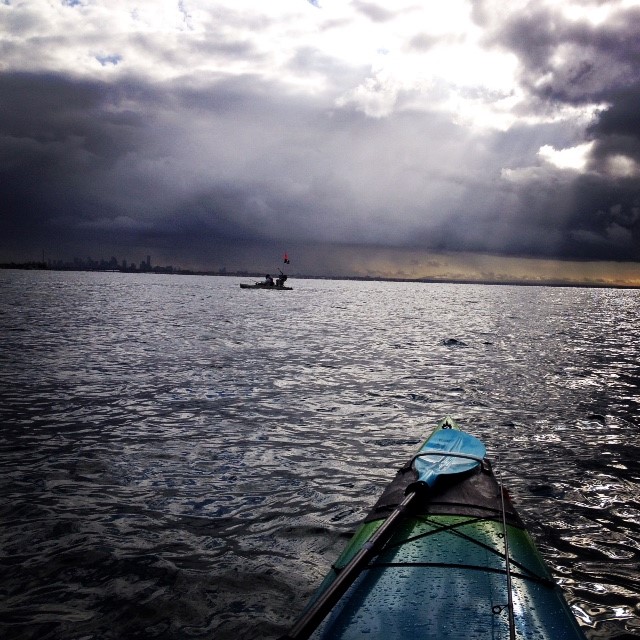 When you get to the water what signs do you look for to make a last go/no go decision?
When you get to the water what signs do you look for to make a last go/no go decision?
I can’t tell you what conditions are right for you, only you can, but stand and watch the water for a few minutes before you launch, trust your gut feeling when it tells you things are getting hairy. It is better to be onshore wishing you were fishing than offshore wishing you were on land. For me personally, I prefer to paddle into a headwind and see the waves coming at me than have a choppy following sea but I know my boat can handle both if need be. I fish stronger winds at anchor than I would drifting because if the drift is too fast it is usually not productive. If there are consistent whitecaps, how comfortable would you be? Fishing should be enjoyable after all. Also when I want to push myself, I always fish in a group with other experienced people.
When you are on the water, what are the tell tale signs to call it a day or risk getting into a spot of trouble.
Go back to the photos in the Beaufort scale link above, if you notice a change in the water, the wind is picking up, was that expected in the forecast or not? If not, then the forecasters probably got it wrong or a change is coming in earlier than forecast. What way is your boat facing/drifting? Has the wind direction changed? Check for an updated weather forecast on your phone/VHF and make the call to move in closer or head in. Keep an eye on the sky for storm fronts/fog rolling in and lastly when in Rome… If everyone around you is packing up in a hurry and heading in there is probably a good reason why!
Tight lines
Sea Sherpa

Storm rolling in at Altona. Photo credit: The Age


